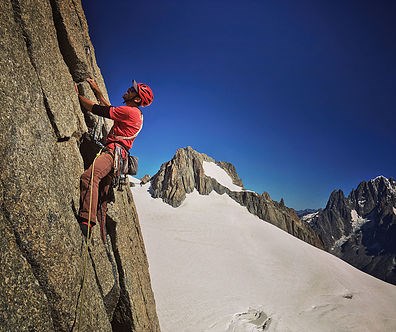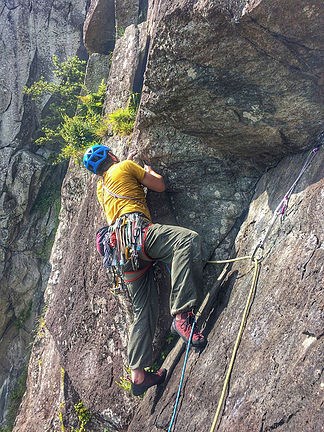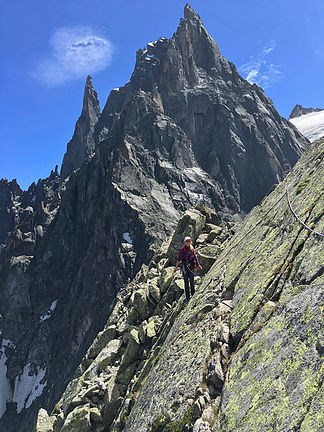Building a Trad Climbing Rack
AMI Member Mike Nolan has taken the time to put together a blog about what he thinks makes up the perfect rack:
Everyone has their own personal preferences when it comes to kit, what items, what brand, how many, what colour... Therefore, I must say, before you go out and spend hundreds on a rack, climb with as many other peoples' gear as possible first so you can decide what you prefer using! This rack and information is based on my own gear and for every person who agrees with what I've listed, I can guarantee there will be 2 who disagree! Hopefully this article will steer you in the right direction though.
The most important thing to remember is that your rack should be flexible and change depending on what you're doing. There is definitely not a one size fits all rack. My rack for guiding somebody on Idwal Slabs will be completely different to my rack when climbing a 1000m long multi-pitch route in the Alps or a single pitch route in the slate quarries! Knowing what to take, and what to leave behind, comes with experience and research prior to climbing a route.
I will focus on a standard beginners rack for somebody who is starting to climb outside, this is the equipment that my clients use when learning to climb, and what I recommend they buy in the future. The rack I recommend will be ideal in most situations, unless you have a weird obsession with climbing off-widths or something – in which case, there's nothing I can do to help you! If you plan on turning up at the crag with this gear, I think you will be able to adequately protect most routes, as long as nothing too specialised is required! (I've climbed E2 on this rack, plus a couple of smaller cams.)

Jez climbing with a stripped down rack to save weight in the
Alps on
the East Ridge of the Pryamid du Tacul (AD 5a)
Belay Device + HMS Karabiner
There's hundreds of different belay devices available, anything from the major manufacturers will be fine, but its worth making sure it has two slots to allow you to use half ropes, which are common when climbing in the UK. Also consider the diameter of the ropes you will be using, and make sure your belay device is suitable. I personally love my DMM Pivot, it's a versatile device which is lightweight + seems to work better than other equivalent devices. Something like the DMM Mantis or Black Diamond ATC-XP will also do the job, or if you're intending on multi pitch climbing, pay extra for a DMM Pivot, Petzl Reverso, or Black Diamond ATC Guide and get a Mountaineering Instructor to show you how to use it! I personally use a DMM Aero HMS with my belay device which is a good size, and balances weight and strength/longevity nicely.
3x D-Shaped Karabiners + 1x HMS Karabiner
You will need these in order to attach to a belay. D-Shaped karabiners go on the gear, whilst HMS karabiners allow you to attach yourself to the gear using clove hitches. I prefer the slightly larger DMM Boa for the HMS, whilst the DMM Aero Offset D or DMM Shadow are great D-Shaped karabiners.
Nut Key
You want to try and avoid leaving your shiny brand new nuts behind if your partner gets them stuck in a crack – you will normally be able to extract them using a nut key.
2x 5mm or 6mm Prussik loops
Whether abseiling off a mountain crag or in to a sea cliff, or helping a stuck or injured partner, prussik loops are very versatile and useful things to have on your harness. Much debate occurs over 5mm vs 6mm cord – I use one of each and rack them together on a screw gate karabiner, such as a DMM Shadow. The cord should be used to create a loop, tying the ends together with a Double Fisherman's.
3x 120cm slings
Useful to always have on your harness, or racked around your chest. Can be used to abseil off a route, clip into somebody's belay, or in self rescue situations. I recommend DMM 8mm Dyneema slings, as they're nice and thin and lightweight. I don't like big bulky slings cluttering up my harness! I carry these slings around my chest with a DMM Phantom clipped to each of them.

Using a standard rack on The Brothers (VS) at Tremadog
Protection
The following rack would be carried by the leader whilst they climb. Remember, certain things might not get taken on every route – I wouldn't ever take hexes on a route with small cracks, for example, or 14 quickdraws on a 10m route at Stanage! It takes experience to be able to adjust your rack depending on the route. Gain as much information of the route from the floor by looking at it and deciding what you might need. On a short gritstone route, I might not bother with the Offsets, whereas on a 40m pitch in North Wales, I would! Whilst you're deciding what to carry, it's always better to play it safe and take more, than to risk it and not have enough gear to adequately protect yourself. I always try to think about what gear I didn't use on a route, and then decide if I can just leave it on the ground next time.
This is the gear that I would usually take to the crag with me (Sometimes I will add some smaller cams and smaller nuts if I'm climbing above E1/2):
The rack I've listed isn't necessarily the cheapest, but I think it's probably the most versatile you can buy at the moment. However, I do appreciate not everyone wants to spend a fortune on their rack initially. It's worth remembering that you can split a rack with a regular climbing partner. One of you could buy the cams, whilst the other buys the nuts and quickdraws. If this isn't possible, or you want your own rack, then swap out some of the lightweight things above for slightly heavier 'versions'. For example, DMM Demon cams are cheaper than DMM Dragon cams, you could even start off without cams, as many people do, relying on hexes more instead.
1x Set of DMM Wallnuts Size 1-11 (Split over 2 snapgates)
1x Set of Wild Country Rocks Size 3-7 (On one snapgate)
1x Set of DMM Alloy Offsets (On one snapgate)
1x Set of DMM Torque Nuts (Split over 2 snapgates)
6x DMM Dragon Cams Sizes 0 – 5 (Each on a separate snapgate)
6x DMM Phantom 25cm Quickdraws
4x DMM Phantom 18cm Quickdraws
4x 'Slingdraws' (Each use 2x DMM Phantom snapgates + 1x DMM 60cm 8mm Dyneema Sling)
Nuts
On shorter routes, you can get away with just 1 set of nuts, however I think that you are always better with a set and a half, which just gives you more options. I would carry 1 full set, and then double up on sizes 3-7, as they are the most popular sizes. I would take these on almost every route. I see offsets as an optional extra, on certain rock types they are brilliant and seem to go in everywhere! On others, I rarely use them. If the pitch is long, I will take them, on a shorter pitch on the grit, I might not bother.
Hexes
They can come in extremly useful on lower grade routes, and are a good alternative to cams if you can't afford them initially. They are also much simpler to place than cams, which is helpful whilst you are starting out! I would recommend buying cams sooner rather than later though. There's nothing more reassuring than a bomber hex placement!
Quickdraws
I prefer longer quickdraws when trad climbing. Short quickdraws seem a bit pointless as they don't really make much difference to the length of a fall, but make a big difference to rope drag. I find the smaller carabiners on the DMM Phantoms fine for both Summer and Winter use, and their lack of weight and bulk makes a big difference over a full size karabiner. The extendable quickdraws are really useful for reducing the drag on a long pitch and they also work as a sling for threads, spikes or pegs, where they can be better than a longer sling. I don't take 14 quickdraws on a 10m gritstone route, but I sometimes add more to my 14 if the pitch is long, or weaves around a lot. Make a judgement, do you really need to place a piece of gear every metre? Don't forget that your cams will have a snapgate on them too, so you won't always need to clip a quickdraw onto them.
Cams
Quick to place, and stronger than people expect them to be, as long as the rocks suitable, they are well placed and well extended, they're great! They also mean certain routes are now much safer than they would have been when they were first climbed! There's a variety available, the most popular seem to be DMM Dragon cams (extendable sling is a bonus!) or Black Diamond C4s (Feel a bit more solid than the Dragons + have a nice thumb loop) - It's worth looking out for the offers! I always carry 4 cams (Size 0-4) and carry smaller or bigger sizes too if the route seems like it may need them. I rack all my cams on individual (colour co-ordinated!) snapgates.
Where to buy...
I recommend
V12 or the
Epicentre, both great shops with knowledgable staff. If you're on a course with an AMI instructor, you'll get a discount voucher as well, bonus!
Mike Nolan
Click here for the websiteOr here for the Facebook page

Using cams and long extenders to protect a traverse and reduce
drag on the Petits Charmoz Traverse (AD) in Chamonix